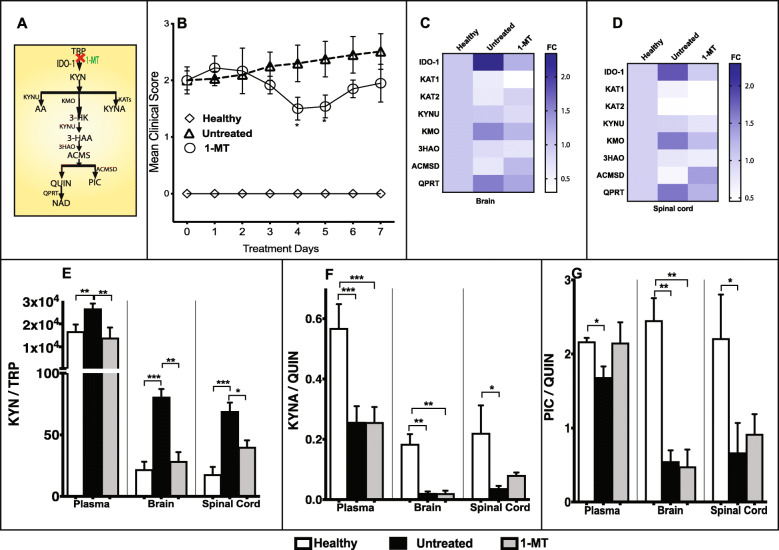Fig. 5.
Early modulation of KP ameliorates the progression of EAE (experimental autoimmune encephalomyelitis). a Schematic illustration of kynurenine pathway (KP). b Mean EAE clinical scores of healthy control (◊, n = 6), untreated EAE control (Δ, n = 6), and 1methyl-DL-tryptophan treated EAE mice (1-MT; IDO-1 inhibitor; O; n = 6, 100 mg/kg; i.p. daily for 7 days) (mean ± SD, *p < 0.05 (1-MT vs untreated EAE)). c and d The heat map shows KP enzyme gene expression in the brain (c) and spinal cord (d) of healthy, untreated, and 1-MT treated EAE mice. Gene expression ranges from high (dark blue) to low (white). e–g Changes in KP metabolites upon treatment with 1-MT. The bar diagrams depict kynurenine and tryptophan (KYN/TRP) ratio (e), kynurenic acid, and quinolinic acid (KYNA/QUIN) ratio (f), and picolinic acid and quinolinic acid (PIC/QUIN) ratio (g) measured (mean ± SD) in the plasma, brain, and spinal cord of healthy (white; n =8), untreated (black; n = 6), and 1-MT (gray; n = 3) treated mice. Three symbols: p ≤ 0.001; two: p ≤ 0.01; one: p ≤ 0.05. IDO-1, indoleamine 2,3-dioxygenase; KAT, kynurenine amino transferase; KMO, kynurenine monooxygenase; KYNU, kynureninase; 3HAO, 3-hydroxyanthranilate 3,4-dioxygenase; ACMSD, 2-amino-3-carboxymuconatesemialdehyde decarboxylase; QPRT, quinolinate phosphoribosyl transferase

